Research
We are doing research on organic solar cells and optoelectronic properties of organic materials. Our interests are focused on the fundamentals, architectures, and device performances of organic semiconductor devices, such as ultra-high purification, doping, and nano-structure design of organic solar cells.
(1)Organic solar cells with p-i-n structure
Organic solar cells (OSCs) are the most promising candidate for next-generation solar cells, which will come after silicon-based cells. Power conversion efficiency of OSCs has remarkably improved in recent years. Organic semiconductors can generate a photocurrent by mixing electron donor and acceptor molecules. Prof. Hiramoto proposed the concept of p-i-n junction of OSCs in 1991. This is considered to be the world's first bulk heterojunction type OSCs from the viewpoint of having a mixed junction i layer by co-evaporation. The bulk heterojunction has become the main stream of current OSCs.

Reference:Appl. Phys. Lett., 58, 1062 (1991).
(2)Ultra-high purification
In order to draw out the real function of organic semiconductors, it is necessary to establish the ultra-high purification technology in organic semiconductors same as silicon. By purifying C60 single crystal using sublimation, we succeeded in ultra-high purification beyond Seven Nine. A p-i-n solar cell using H2Pc and C60 with high purity achieved a short circuit photocurrent of 20 mA/cm2, which is comparable to a silicon solar cell, and a world best conversion Efficiency 5.3% at that time.
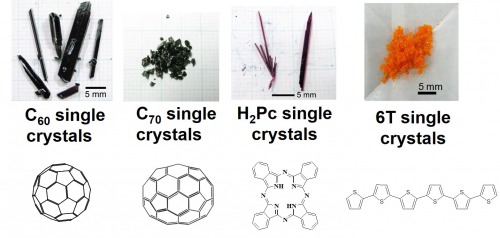
Reference:Mol. Cryst. Liq. Cryst., 491, 284-289 (2008).
(3)pn Control of organic semiconductors by impurity doping
A pn control by impurity doping is an essential technology for semiconductor electronics. We succeeded in converting to p-type and n-type by adding trace amounts of impurities to organic semiconductors such as fullerene and phthalocyanine. We also successfully fabricated pn homojunction organic solar cells using these organic semiconductors. This pn control technique could apply for other representative organic semiconductors.
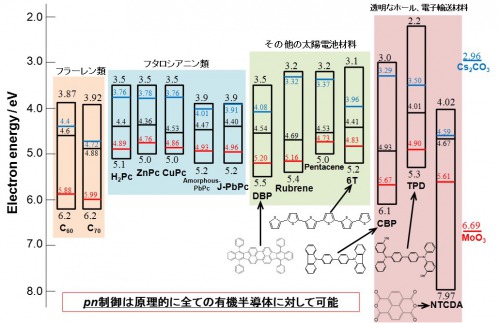
References:Electronics, 3, 351 (2014)., Appl. Phys. Lett., 98(7), 073311 (2011).
(4)Tandem organic solar cells by using impurity doping
We succeeded in making tandem type solar cell by using the precise pn control technology into co-evaporated organic semiconductor film. Compared to the single cell, we observed that the open-circuit voltage improved about twice in the tandem cell. This result shows guidelines for design of tandem type OSCs.
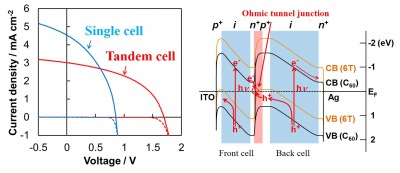
Reference:Org. Electron., 14, 1793 (2013).
(5)Effects of doping at the ppm level in organic solar cells
We succeeded in doping of the active layer of OSCs with trace amounts of impurities at ppm level. It has been clarified that impurity doping at ppm level improves the fill factor and short circuit current density due to the increase of majority carriers and the increase of built-in potential.
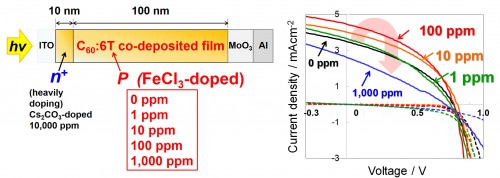
Reference:Org. Electron., 27, 151-154 (2015).
(6)Organic solar cells using lateral charge transport
By using organic single crystals, we succeeded in prototyping an organic solar cell that extracts charges in the lateral direction. At the same time, the range of charge in the lateral direction was observed by changing the distance between the electrodes.
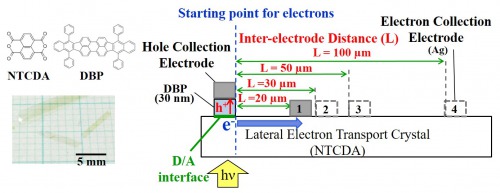
Reference:Org. Electron., 41, 118-121(2017).
(7)Lateral alternating donor/acceptor multilayered junction for organic solar cells
Lateral alternating multilayered junction using a high-mobility organic semiconductor is proposed and demonstrated. A total of 93% of the photogenerated electrons and holes are laterally collected over a long distance (0.14 mm). It can be an alternative blended junction for organic solar cells.

Reference: ACS Appl. Energy Mater., 2, 2087–2093 (2019). Press Release
(8)Hall effect in bulk-doped organic single crystals
By combining the organic single crystal growth technique and ultra-low speed deposition technique, we fabricated a rubrene single crystal doped at extremely low concentration of 1 ppm and succeeded to detect the Hall effect signal. We found that the doping efficiency of the organic single crystal is 24%, which is remarkably higher than 1% of the amorphous film of the same material. This research leads to the creation of a new field of organic single crystal electronics using organic semiconductor single crystal similar to electronics using silicon single crystal wafer.
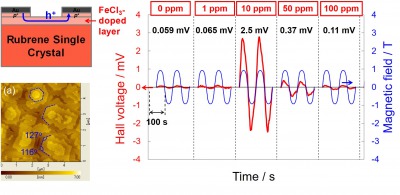
Reference:Adv. Mater., 29, 1605619 (2017). Appl. Phys. Lett. 115, 113301 (2019) Press Release
(9)Doped organic single-crystal photovoltaic cells
Doped rubrene single-crystal photovoltaic cells were fabricated. A single-crystal substrate collected excitons by long range diffusion to the pn-homojunction interface.

Reference: Org. Electron., 64, 92-96 (2019)
(10)Control of interfacial structure in organic solar cells
In OSCs, charges are generated at the electron donor/acceptor (D/A) interface by charge separation from coulombically bound exciton. We are searching the optimal interfacial structure for photoelectric conversion by controlling the nanostructure near the D/A interface.
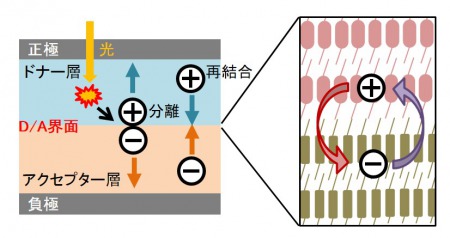
Reference:Org. Electron., 55, 69-74 (2018).
(11)Reducing open-circuit voltage loss in organic solar cell
Organic solar cells with high mobility and highly crystalline donor (D) and acceptor (A) materials were able to reduce an open-circuit voltage (Voc) loss. The origin of the high Voc was that the highly crystalline D/A interface reduced the energy loss related to charge recombination.
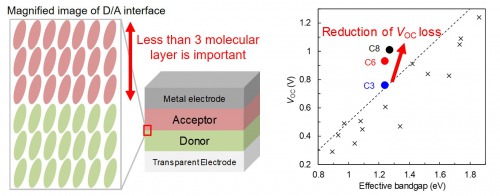
Reference: Appl. Phys. Lett. 115, 153301 (2019). Press Release
(12)Doping for controlling energy level allignment at the donor/acceptor interface in organic solar cells
Effects of energy level allignment at the donor/acceptor (D/A) interface on photoconversion processses in OSCs have been clarified. We have succeeded in improving the open-circuit voltage in OSCs by controlling energy level allignment by doping.
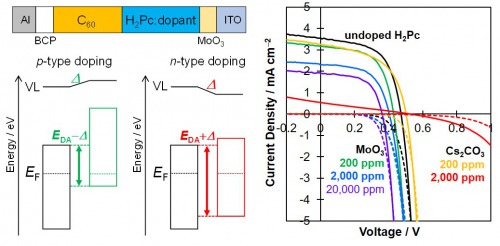
Reference: J. Phys. Chem. C, 122, 5248-5253 (2018), J. Phys. Chem. Lett., 9, 2914-2918 (2018).
(13)Organic pn homojunction solar cells
pn Homojunction in single organic semiconductor achieved efficient charge separation. Increase of photocurrent by 8 times from undoped to 5% doping was observed. Charge separation was assisted by a built-in potential near the pn homojunction.

Reference: Org. Electron., 71, 45-49 (2019).
(14)Development of novel non-fullerene acceptors
The photoconversion efficiency of organic solar cells has improved rapidly in recent years and has exceeded 17%. The main factor is due to the use of semiconductor molecules having a large light absorption in visible region, other than fullerene as the acceptor material. Our laboratory is also developing non-fullerene acceptors with high crystallinity and excellent light absorption and electron transport properties.

